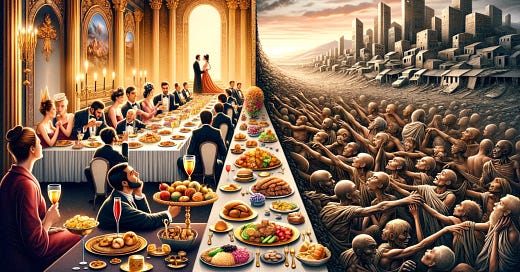Never Mind the Gap
Which is better: Set a policy that reduces the wealth gap or set a policy that makes everyone better off, especially the poor?
One also encounters a depraved taste for equality in the human heart that brings the weak to want to draw the strong to their level and that reduces men to preferring equality in servitude to inequality in freedom.
—Alexis de Tocqueville
Occupy Wall Street (OWS) was all the rage, as was the Tea Party (TP). The culture wars had been simmering beneath the surface at a time dominated by the memetics of class warfare. Sadly, the OWS and Tea Party failed to see what they had in common: Both hated policies that propped up the wealthy at the expense of the poor and middle class. Yet such policies have been the norm for a very long time, as ordinary people have been forced to bail out banks and subsidize grotesque corporations in the form of debt spending and inflation—for decades. But OWS and TP did not cooperate. So they were divided and conquered. OWS focused on “Rich evil!” TP focused on “Gubment bad!” Neither focused on the dynamic interplay between Big Finance and Big Government as they pillaged the rest of us and do so to this day. -MB
Bill Gates and Warren Buffett are sitting at a diner drinking malted milkshakes. This is not the first line of a joke. Someone snapped a picture of this scene in Omaha, Nebraska, back in 2010. The image appeared with a Forbes article about a plan the two were hatching. Two of the world’s richest men were discussing an idea that came to be known as the $600 Billion Philanthropy Challenge.
“Gates and Buffett started what can be called the biggest fundraising drive in history,” Carol Loomis wrote of the moguls.
They'd welcome donors of any kind. But their direct target is billionaires, whom the two men wish to see greatly raise the amounts they give to charities, of any and all kinds. That wish was not mathematically framed at the time of the New York meeting. But as two other U.S. dinners were held (though not leaked), Buffett and Gates and his wife, Melinda, set the goal: They are driving to get the super-rich, starting with the Forbes list of the 400 wealthiest Americans, to pledge – literally pledge – at least 50% of their net worth to charity during their lifetimes or at death.
The pledge is an ambitious and noble undertaking. It means persuading others to give a lot of their money to good causes. Interestingly, it had come on the heels of Buffet’s 2006 commitment of more than $1 billion a year to the Bill and Melinda Gates Foundation, the world’s largest charity.
But what does it mean?
Revealed Preference
Economists have a concept they refer to as “revealed preference.” This is a fancy way of saying you can get a good idea about what people want by observing what they do. People’s actual choices reveal their preferences. It doesn’t always work. People are complicated creatures and can be motivated by multiple, often conflicting desires. You might not want to visit your in-laws, but you want to keep your spouse happy. In this case, you have demonstrated a preference, not so much for spending time with in-laws, but for maintaining domestic tranquility.
Still, most of the time, we can figure out someone’s preferences through her actions. If somebody spends an hour at the movies rather than at the park, we can make an educated guess that she prefers the movies to the park at that moment. It could be that a park hijacker told her to “go to the movies―or else!” But chances are she ranked the movie higher than the park among the available alternatives of things to do that day.
Then she acted.
Similarly, if Warren Buffett gave large sums to the Bill and Melinda Gates Foundation rather than giving those same sums to the Thiel Foundation, we can make a pretty good guess that Buffett prefers giving to the Gates Foundation. Again, revealed preference―which is rooted in people’s real choices―can tell us a lot about what people prefer.
Only about a year after Gates and Buffett decided to convince other billionaires to give half of their net worth away to charity, Buffett said: “My friends and I have been coddled long enough by a billionaire-friendly Congress. It’s time for our government to get serious about shared sacrifice.” Specifically, Buffett wanted the federal government to tax the rich at a higher rate—even if that meant double taxation.
All of this prompts the question: Is Warren Buffett serious about shared sacrifice?
It depends on what you mean by the term.
If shared sacrifice means helping the world become a better place, Buffett is, indeed, serious about both entrepreneurship and sacrifice. As we point out, the Oracle of Omaha is giving boatloads to charity each year. But I’m not so sure he’s serious about billionaires paying more in taxes. Buffett’s is an example of Machiavelli’s cynical twist of an old line from Cicero: Videri Quam Esse – “to seem rather than to be.”
How do we know?
Keep reading with a 7-day free trial
Subscribe to Underthrow to keep reading this post and get 7 days of free access to the full post archives.





